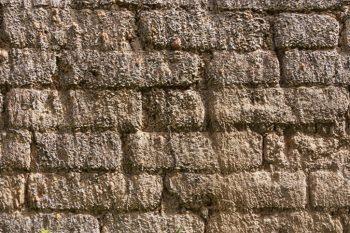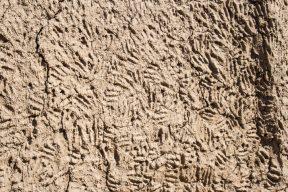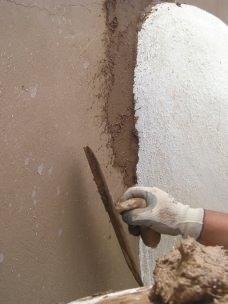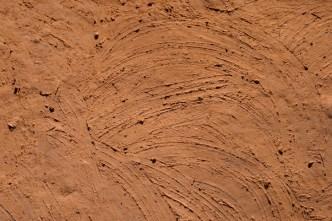Coatings in clay
Post from EditorialsThe coating in clay has no environmental impact and it can be returned to nature without any risk to human health and the environment.
To use clay as a material for construction is an ancient technique that has been revived today not only for its strong relationship with the environment, in fact, the clay is a natural material and it is easy to find, but also because it draws the ancient building techniques and manual work in building.
Since ancient times, buildings were constructed in raw earth. Today the criteria of green building recover this ancient building technique.
The basic element of the raw earth is clay, which has high plasticity linked to a good ability to absorb water. The clay is divided into two categories, lean or rich, that depend upon the more or less consistent presence of sand.
How do you work clay?
Before the raw earth can be used in construction must undergo a series of processes. First it has to be dried in the sun and then it is mixed so as to obtain a uniform mixture, in virtue of the consistency that you need, you can add fat clay, sand, etc. ... The clay is produced directly on site and there are 4 different processing techniques.
The clay is produced directly on site and there are 4 different processing techniques.
The the Adobe technique implies that the mixture which then will go to form the brick, will undergo the process of drying inside a wooden armor.
All these elements will then be solidarized together by the use of a binder which is also made in raw earth.
Another technique is Pisè, it isvery similar to the previous one in the operations mode to be performed with the difference that the dimensions of the brick are equal to the width of the wall and have a height of about 50 cm.
Then we have the Bauge technique that does not involves the use of formwork. According to this technique that is always carried out in situ, the mixture is made of clay mixed with straw or other vegetable fibers, and then is subsequently processed by removing the excess or irregular parts.
The last, but not least, is the Torchis technique which also uses the wooden structure and clay cladding.
The earth is the main element that constitutes our planet, this according to its mineralogical composition and therefore the place of extraction has different features and colors.
Sometimes this can be excessively friable and therefore it requires the addition of further materials to improve its resistance, binder materials such as cement, lime or bitumen, although always in small percentages. In this case the raw earth becomes stabilized earth and it is not used anymore for building purposes but for road foundations for the realization of such avenues with specialexternal draining and vehicular floors.
Raw land as a coating
For its physical-mechanical characteristics, the raw earth can not be used as a structural material, in fact we find it endeavored to realize partition walls and finishing works.
If we wanted to make a plaster in clay, we wouldn't need either skilled workers nor any special equipment.
You prepare a network on the wall surface to be plastered, which has the function of making uniform the surface of application, which may have been made with different materials whose surface may not be continuous and homogeneous. This material is available in different colors and its variety is determined by the different geographical origin, the different shades generally are combined with warm colors, which can give to the environment very pleasanteffects, both in terms of aesthetic and sensory in general, as touch and smell.
This material is available in different colors and its variety is determined by the different geographical origin, the different shades generally are combined with warm colors, which can give to the environment very pleasanteffects, both in terms of aesthetic and sensory in general, as touch and smell.
The last layer of finishing, the more superficial, may make use of different types of machining, such as engraving, polishing by the use of natural oils, the addition of powders or other pigments in order to obtain different colors by the basic ones.
One of the most pleasant characteristics associated with the use of this coating in raw land is that its origin, entirely natural, favors the effect of synesthesia that in addition to touch and sight, involves the sense of smell due to the presence of natural aromas and flavors.
Where and why use coatings in clay
 We find coatings produced with this particular technique especially in indoor environments. If the layer of plaster is applied to a suitable surface treatment to protect them from water and alcohol, the coating in clay can be used as a coating in environments subject to fumes and vapors, such as bathroom and kitchen. It can also be used for the finishing of the floors, but this is only possible if properly reinforced with specific mechanical treatments.
We find coatings produced with this particular technique especially in indoor environments. If the layer of plaster is applied to a suitable surface treatment to protect them from water and alcohol, the coating in clay can be used as a coating in environments subject to fumes and vapors, such as bathroom and kitchen. It can also be used for the finishing of the floors, but this is only possible if properly reinforced with specific mechanical treatments.
In addition, because of its aesthetic features that recall also the awakening of the senses, the coating in clay is also found as a coating in an environment dedicated to relax and well-being, and in environments of representation precisely because it make for a comfortable and relaxing environment in which they are used. Several are the reasons why you choose this type of coating. Surely the simplicity of processing. It also guarantees a high thermal comfort due precisely to its consistency, which ensures low heat loss during the winter season, and a good thermal insulation during the summer. Because of its good texture, the use of this plaster-based raw land favors the acoustic insulation of the covered space.
Several are the reasons why you choose this type of coating. Surely the simplicity of processing. It also guarantees a high thermal comfort due precisely to its consistency, which ensures low heat loss during the winter season, and a good thermal insulation during the summer. Because of its good texture, the use of this plaster-based raw land favors the acoustic insulation of the covered space.
With regard to the environmental comfort, the breathability of raw land mitigates the inner moisture, and prevents the air to be either too dry or too moisty.
Even from the economic point of view to make a plaster earthen it is appropriate, not just because it is easily available on the market, but also because the costs of transport and disposal, also of the resulting material, or of the excess material is almost void.
79870 REGISTERED USERS










